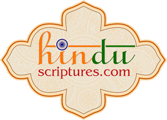AVALOKITESHWARA
Contents
. Introduction
. Abode of Avalokiteshwara
. Literatures associated with Avalokiteshwara
. Statues of Avalokiteshwara
. Tiantai School of Buddhism
. Tibetan Buddhism
. Avalokiteshwara with thousand arms
. Manifestations of Avalokiteshwara
. Conclusion
Introduction
![]()
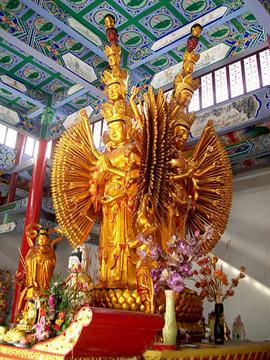
Avalokiteshwara is portrayed in different cultures as either male or female. Avalokiteshwara is a combination of Ava meaning down, Lokita meaning to behold or observe the world and Eshwara meaning sovereign, master or ruler. Hence Avalokiteshwara implies ‘The lord who gazes down at the world’. He is the Bodhisattva who has as his life’s goal assisting all sentient beings to achieve Nirvana and may even postpone his own Buddhahood until he achieves this goal. He is moved by compassion seeing their sufferings and is born in a heavenly realm from where he works tirelessly to help and relieve all those who call upon his name. His name appears to be mentioned from the first century BCE. In Chinese, Japanese and Korean traditions, he is often depicted as a female and in other cultures he is depicted as a graceful youth with gentle demeanour.
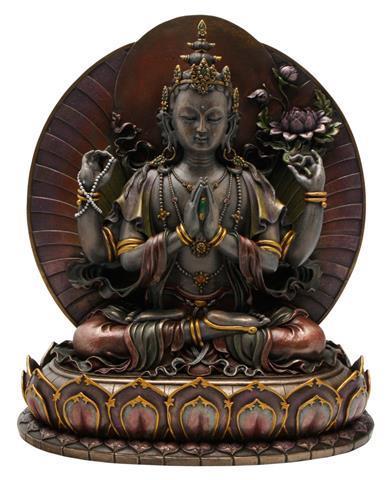
Abode of Avalokiteshwara
Avalokiteshwara was believed to abide in a remote part of India on a mountain from where he is supposed to look down with compassion upon the world though through prayer and supplication he is accessible to anyone, anywhere and at any time. This mountain was called Potalaka or Potala and it was a sacred pilgrimage spot earlier but due to the journey being fraught with dangers it is no longer visited much in the present age. Called Potikai today, it is the highest peak at 2726 mts in Ambasamudram in the Tirunelveli range situated on the border between the States of Tamil Nadu and Kerala. But Chinese Buddhism states that the sacred mountain is actually a rocky island now called Putuo Shan off the coast of Zhejiang province and is one of the four sacred mountains in Chinese Buddhism. In Tibet since the Dalai Lamas are considered the incarnations of Avalokiteshwara, their residence is called the Potala Palace.
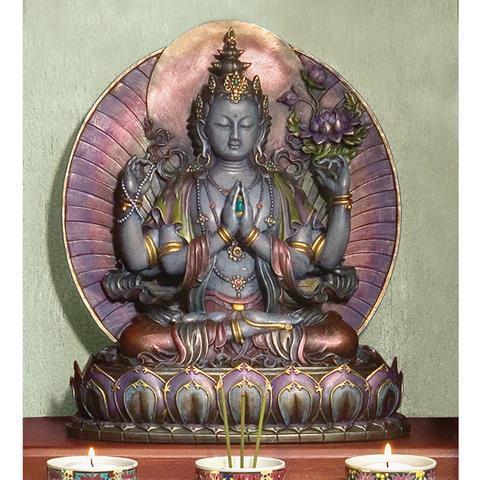
Literatures associated with Avalokiteshwara
1. Lotus Sutra or Saddharma Pundarika Sutra
2. Heart Sutra or PrajnaparamitaHrdaya Sutra
3. Karandavyuha Sutra
4. Cundi Dharani Sutra
5. Mahakaruna Dharani Sutra or nilakanta Dharani
6. Avalokiteshwara Ekadasamukha Dharani Sutra
The Lotus Sutra is the earliest literature which expounds the doctrines of Avalokiteshwara. The 25th chapter of this Sutra is devoted to Avalokiteshwara describing his mission, his 33 manifestations including female manifestations. The chapter is named ‘The Universal Gateway of Avalokiteshwara Boddhisattva’. It consists of a prose and verse section. This chapter is separately recited in most Buddhist temples in East Asia as Avalokiteshwara Sutra.
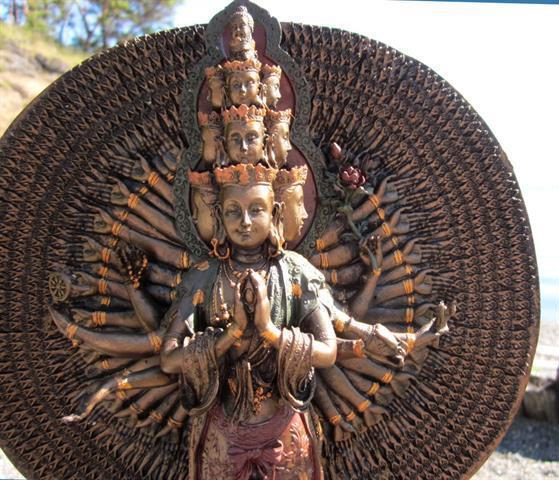
Statues of Avalokiteshwara
Until the 12th Century Chinese travellers have recorded accounts of statues of Avalokiteshwara being revered by devotees from all walks of life, from King and monks to laymen. Then later the Buddhist monasteries were destroyed by the invading Muslim rulers. In East Asia and China, the 18 armed form of Avalokiteshwara was revered and known as Cundi also referred to as Cundi Bhagavati or Cundi Buddha- Mother.
Tiantai School Of Buddhism
The Tiantai School of Buddhism in Korea, China, Vietnam and Japan gives the Lotus Sutra as the central role in its teachings wherein Avalokiteshwara is defined as having six forms. There are six realms of existence according to them – Hell-beings, pretas, animals, humans, asuras and devas. Each form of Avalokiteshwara represents one of the six qualities which are-
1.Great compassion
2.Great kindness
3.Immense courage
4.Universal light
5.Leader of human beings and devas
6.The great Omniscient Brahman
These six qualities are said to break the hindrances of the six realms of existence respectively.
Tibetan Buddhism
In Tibetan Buddhism, Avalokiteshwara has seven forms-
1.Hayagriva -with the head of a horse.
2.Amoghapasa-an empty net or lasso
3.Sahasrabhujalokeshvara-1000 eyes and 1000 hands
4.Chintamani chakra-wheel of sovereign power
5.Cundi
6.Ekadashamukha-with 11 faces
7.Arya Avalokiteshvara-the great compassionate one.
According to Tibetan traditions Avalokiteshvara is actually Brahma who became one of the two major disciples of Sakyamuni Buddha from the Deva realms, the other being the King of Gods Indra who became known as Vajrapani. It was he as Brahma who convinced Buddha not to stay in seclusion after his enlightenment but to begin preaching.
In Sri Lanka Avalokiteshwara is referred to as Natha. In Burma he is worshipped as Loknat and in Thailand as Lokeshvara. Avalokiteshvara is associated with the six syllable mantra-Om Mani Padme Hum- and is also referred to as Shadakshari or Lord of the Six Syllables. The most popular religious practice in Tibetan Buddhism is recitation of this Mantra along with prayer beads.
Another mantra chanted is Namah Srimadavalokiteshwaraya.

Avalokiteshwara with thousand arms
Buddhist folklore says that since Avalokiteshwara could not free all sentient beings from worldly bondage and many of them were still suffering, struggling to comprehend their needs his head split into eleven pieces. Seeing his plight the Buddha gave him eleven heads to enable him to hear the cries of the suffering. But when he reached out to help them he was unable to do so hence his two arms shattered to pieces. Buddha came to his aid and gave him a thousand arms to help others. This image exists in the Bao’en temple in Sichuan China.
In Tibet this image is known as Sahasra Bhuja(thousand armed form) and Ekadashamukha(eleven faced form)
Manifestations of Avalokiteshwara
|
Sanskrit |
Meaning |
Description |
|
Aryavalokitesvara |
Sacred Avalokitesvara |
The root form of the Bodhisattva |
|
Ekādaśamukha |
Eleven Faced Avalokitesvara |
Additional faces to teach all in 10 planes of existence |
|
Sahasra-bhuja Sahasra-netra |
Thousand-Armed, Thousand-Eyed Avalokitesvara |
Very popular form: sees and helps all |
|
Cintāmani-cakra |
Wish Fulfilling Avalokitesvara |
Holds the bejeweled cintamani wheel |
|
Horse Headed Avalokitesvara |
Wrathful form; simultaneously bodhisattva and a Wisdom King |
|
|
Mother Goddess Avalokitesvara |
Portrayed with many arms |
|
|
Amoghapāśa |
Avalokitesvara with rope and net |
|
|
Bhrkuti |
Fierce-Eyed |
|
|
Pāndaravāsinī |
White and Pure |
|
|
Parnaśabarī |
Cloaked With Leaves |
|
|
Rakta Shadaksharī |
Six Red Syllables |
|
|
Śvetabhagavatī |
White-Bodied |
|
|
Udaka-śrī |
Water Auspicious |
Conclusion
Beings like Avalokiteshwara manifest due to their extreme compassion to mankind unable to withstand the suffering cries of humanity, the essence of Buddhism being primarily to understand and transcend suffering.
1. Wikipedia.com
2. Buddhisma2z.com
3. Buddhanet.net
4. Buddhism.about.com
5. Dharma-haven.org
